There are two distinct versions of signal, the tall fin, and the short fin. All Eagleluxes were of the tie-rod design, with two end plates holding together the group of common signal sections. The earliest of these plate styles was known informally as the Tall Fin. It was a significant flange, around 1 3/8", on the front face of the signal featuring a gentle, rounded arch shape and adding significant height to the front face of the signal. In later years this was modified down to 3/4" tall to only be a small, Short Fin which kept a similar arch profile but was barely taller that the thickness of the plate it was made to,. The top and bottom plates were interchangeable and only distinguishable because the ID tag went on the bottom. They were built with a inset flange designed to mate with the tapered body housings, the upper part of the signal was narrower and set inside a lip on the endplate while the lower part of the signal was flared out and set outside the endplate lip. This same philosophy also allowed the bodies to stack securely amongst themselves. These photos show a tall fin plate vs. a short fin plate. They are virtually identical except for the holes drilled (or not) for an ID tag and a few extra ejector pin locations on the short fin model. There were at least five types of finned plates. Long fin plates were the first version and were produced with one and three ID tags, possibly even two ID tags, and the short fin plate, introduced around 1950 was produced with and without an ID tag. The plates typically had a 1 1/2" pipe clearance hole, although a 2" pipe option was also available by special order.
Signal breakdown
(Thanks to SEMICH_EL for a clean scan of the catalog page)

Fin comparison
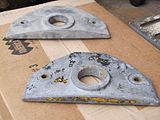

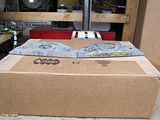
Tall fin signal photo
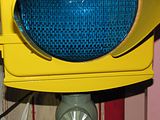
Short fin signal photo
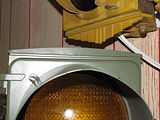
Tie Rods
Tie rods held the signals together. For most of the run, the rods were capped with a standard hex nut fused to a brass or steel acorn shell. Eagle did not use true (solid) acorn nuts. Late productions of the short fin Eaglelux moved to the Rodded Eagle style of tie rodding with a long square head bolt inserted from the top and the nut applied to the bottom of the signal only. Lead washers were used for sealing the tie rod holes in both cases.
Long fin with faux nuts
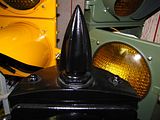
Short fin with square bolts

Terminal Blocks
Some Eagleluxes, at least early in the long-fin era, came with a terminal block manufactured specifically for Eagle. The earliest type was a fibrous paper laminate block with metal tabs for the connections. A later version was this early plastic composite model. This plastic, similar to that of the deco signals, often aged poorly and crumbles apart as this example is doing.

Reflectors
Reflector frames also changed over the years. The earliest models had each piece (frame, lampholder, and latch) individually screwing together with miniature screws and nuts. Later versions riveted the latch directly to the frame. It wasn't unusual to find glass or Alzak plated aluminum reflectors in these signals.
Early reflector
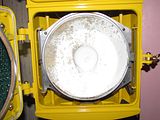
Later reflector
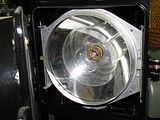
Finials
Eagle has offered both the stubby and the tall finial for post mount signals. Early on, Eagle pitched the tall finial for post mount signals with the stubby finial reserved for decorating mounting hardware. By the 50's, however, Eagle seems to have dropped the large finial and was now selling the stubby finial both for pipe fittings as well as being the finial of choice for post mount signals.
Tall finial on tall fin signal

Stubby finial on shortfin signal
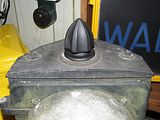
Hinge Pins
There were at least two distinct types of hinge pin used on the Eaglelux. Most signals seem to have used a round headed brass rivet as the hinge pin. Late production models went to a flat headed stainless pin instead.
Early pin

Late pin

Logos
There has been at least three body styles used, identifiable by the logo molded into the back. Blank bodies are found on all tall-fin, and some early models of short-fin. The back of the casting featured a prominent mold insert imprint but was devoid of any manufacturer's indication. The reason behind this is unknown. Later models of the short fin did incorporate the Eagle Thunderbird outline with the raised text "EAGLE SIGNAL CORP" incorporated onto the figure. It is believed the earlier versions used a climbing script version of the word Signal, with later ones using the same font as the words Eagle and Corp always did, a plain sans-serif font.
No Logo Body
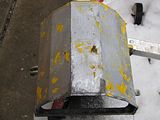
Non-Script Logo
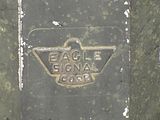
Script Logo

Screws
At some point in the production run, Eagle experimented with that new for 1934 device, the Phillips screw. This appears to be short lived, as only a few Eagleluxes have been seen without slotted screws, and by the time of the rodded flatback slotted screws were again in use. Perhaps this was around 1950 when the patent was revoked and the screw, ubiquitous to the market now, was first available cheaply to the masses.
Visors
Both cap and tunnel visors were popular accessories, full circles were used in the west and other variants were available as well. The earliest of visors are believed to have been made of rolled aluminum and steel sheet, with the visor tabs being heavy brass L-brackets with one rivet into the visor and screwed to the signal in a conventional manner. The remaining visors kept to the simpler design of a rolled sheet with a folded up tab to bolt to the signal. Through the years these went through both small, thin tabs with a drilled hole and larger modern type tabs with a slot to allow easier installation and removal.
Lens Tabs
As the Eaglelux was a long serving signal it is quite apparent the design was modified to keep up with the latest trends. The first lenses were held into the signal with four steel quarter-rings that interlocked. A lens to signal body and a lens to ring cork gaskets were apparently used from the start of production, however due to their fragility and short life, most signals are devoid of original gasketing. In later years these two pieces of cork became the modern single wraparound rubber gasket, still secured with the four part ring. The last of the Eagleluxes used conventional lens tabs on the bosses of the original quarter rings.
Accessories
Downlights were available for Eagleluxes.
This first photo shows a combination downlight and bottom plate cast unit. It used a hinged access door on the bottom as a lamp cover, the same as later downlight designs.
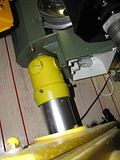
This second set of photos shows a downlight door. It would replace a conventional door on a signal body. A cover could be bolted to the bottom to protect the lights. Lamp sockets mounted horizontally to a bar that bolted to the two eyelets seen in the body of the door.

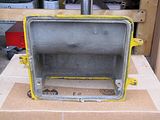
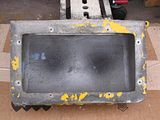
Blank doors were also popular for special applications. Here is a heavy steel/iron blank door. It is cast without any partnumbers or other markings.
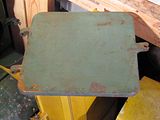
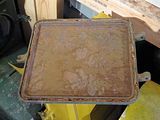
Lenses
All lenses described below are 8 3/8" round.
Diffusing (crosshatch)
Kopp 27
Kopp 27 Commands (STOP, CAUTION, GO, FIRE)
WAIT-WALK lenses
Neon WAIT-WALK (1953)
Kopp 88
Kopp 88.1
Kopp 88.a
Chinese one-way arrow, red and green
Chinese 90° two-way arrow, green
Broad-head arrow, green
Door Timeline
There were many types of doors used on the Eaglelux during its long run. The correct order and all varities of doors is still under study. Here is a brief roundup of doors (which may or may not all be Eaglelux) and some information about them.
The earliest Eaglelux doors were the cast (K-282) and removable-cast visor doors with door-mount reflectors, a carryover from the Ornamental solidbody Eaglelux days.
This door is also a model K-282, it was also produced as the integral cast visor door. The bolt-on visor version has a prominent beveled lip around the lens on the frontside where the tooling was reworked to remove the cast visor. It was used with the lens retaining ring and the early style visors. In the lower left, this particular unit was marked [ALUMAC] N.J. K-282. This door, when opened, is easily identifiable because it retains the vestiges of the door reflector mount hinges and latch. The visor on this door is aluminum but also has rivited brass visor tabs to mount it to the door, mounting to the door with slotted screws. This door came off of a no-logo tall fin Eaglelux signal out of Detroit, MI. This door used brass round-head pins for the hinges and latch and would have been on a tall fin Eaglelux signal. Lenses were Kopp 27 and 88a.
K-282 door with cast visor and reflector mounts
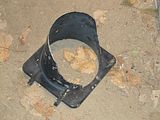

K-282 door with cast visor and no reflector mounts
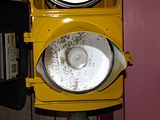
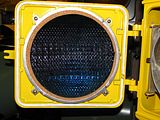
K-282 with conventional bolt-on visor and no reflector mounts
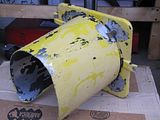
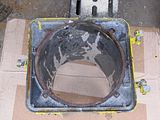
This door is a model K631. It was used with the lens retaining ring and the early style visors. The only marking is in the lower-left of the inside of the door. This door is most identifiable because of the door-latch eyelet doesn't mold into the door like others, it stays mainly off to the side of the door. The visor used with this door is all steel with riveted brass visor tabs, mounting to the door with slotted screws. This door came off of a 4-way signal in Florida, the other sections were cast visor/door reflector types. This section could have been added at a later date or it could have been the first non-cast visor door?
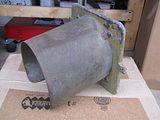
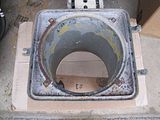
This door is a model K-710. It was used with the lens retaining rings and would likely also have been used with lens clips and a rubber gasket. In the upper left, these units were marked K-710 [ALCOA] X. This door is cleaned up from the earlier Eaglelux version. On the outside, the overlaps from the hinge/latch tabs and door are much less prominent and do not carry the design onto the door face. On the inside of the door, all traces of the door-mount reflectors are gone, the lens mounting bosses are reduced in size, and the ejector pin stubs are relocated. The visor for this door is aluminum with bent tabs as part of the visor itself, the tabs having a hole drilled for mounting to the signal. This door came off of a no-logo short fin Eaglelux signal KB-S14 out of Michigan. This door used brass round-head pins for the hinges and latch. Lenses were Kopp 88a. Reflectors for this signal were aluminum or glass, the catch tab on the reflector frame would have been rivited on.


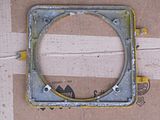
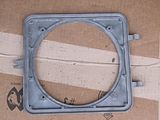
Door K-630 was used during the WW2 material substitution and produced in limited numbers. It's believed all copies of this door were made of steel/iron and not of aluminum. It closely resembles the K-631.
Door K-765 was also used for the Eagleluxes.
Doors K-576 (removable) and K-527 (fixed) were also used in the cast visor era.
This door is a PKC-6-EX used on later Eagles. It's known as the lift-off door because it only uses a single clip on the upper hinge to lock the door to the body, and once removed the door can be lifted up 1/4" and removed from the signal. It is marked PKC-6-EX (R) in the upper right corner. The lower hinge is cut back much further from the door face than the upper hinge.
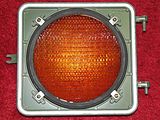
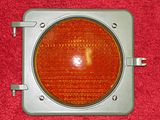
This door, PKC-330, was used on the following generation of signals, the rodded flatback. It may have also been used on later short fin Eagleluxes.
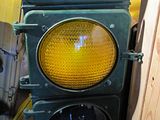
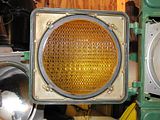
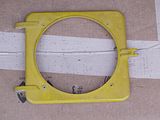

ID Tags
All tall-fin models came with one or more ID tags installed. Some, if not all, short-fin models also came with an ID tag. There were several variations over the years, and the following is speculative data on when and what order and dates they were used.
Brass vs. Aluminum tags. The earliest tags were made of brass, with later signals moving to aluminum tags (in the tall fin era). It is possible that in the final years of the tall fins or during the short fins, tags were changed back to brass. [Look at if this was related to WW2]
Eaglelux ID Tag Relative Orders
Something I'd been working on and will move to the WIKI sometime soon.
The relative date of an Eaglelux signal can be dated by the type of ID tag used on it in addition to the numerous design modifications these signals underwent through the years.
1930-1933 [approx.]
The earliest ID tags were found on the first lights of course, these being the solid body signals such as this tag from an Ornamental Eaglelux. This might be the earlier of the two Ornamental tag types known, as it uses the Eagle Signal Sales Corp aka "ESSCo" and Harrington-Seaberg names, a three-way confluence of companies we've yet to figure out!

Here is another, presumably later set of tags from an Ornamental Eaglelux and a Northern Electric Ornamental Eagle Copy.


1934-1937 [approx.]
The first true Eaglelux adjustables and 4-ways, with cast reflectors and door-mounted visors used ID tags in this style. Here are examples from 1934 and 1937 4-Way signals.


July 1938 - September 1942 (Earlier Style)
As Eagle began their evolution towards a modern signal design the reflector frames were now mounted inside the body and visors were available in both cast-in-place and the more modern removable style. Some of the earliest removable ones were identifiable by rivited brass tabs for mounting the visor to the signal. This is a tag representative of these late 30's-1940's era lights. It has a standard Eagle ID tag, and two accessory tags, one for a legacy patent issued in 1921 and lasting until 1941, and one for an applied-for [Jul 25, 1938] future patent. Note, the third pic one of the ID tags fell off.



July 1938 - September 1942 (Later Style)
Eagle also produced a second set of ID tags in this era, these having moved the notes on the two accessory tags back onto the main ID tag. Some batches of bottom plates were caught in this transition having only one ID tag yet monuting provisions for all three tags still up through the WW2 "steel bodied" signals Eagle was producing when aluminum was rationed.


September 1942 - Early 1950's
Following the issuance of Eagle's patent in 1942, the ID tags were revised to remove references to the 1,490,567 patent and replaced by Eagle's own patent 2,294,883 for the Eaglelux signal. At this time, ID tags were also revised to be made of a much lighter, thinner, and cheaper aluminum/steel. Previously, all ID tags were made of heavy brass. These last generation of ID tags were in use up until some time in the 1950's, generally used on both the long and short-fin Eaglelux signals, although once the body style was changed to have the Eagle logo on the back the ID tag was redundant and no longer applied to signals.




















